
Jim Sarsfield of the Small Battery Company may not know it, but his name is very well known in my country. Patrick Sarsfield the Earl of Lucan, was a well known Jacobite soldier and we were taught a lot about him in our history lessons at school. His battle cry was ‘Sarsfield’s the word, Sarsfield’s the man’. Jim Sarsfield, no relation as far as I know, certainly is a man of his word and the Wein Cell which he supplied to me has breathed a welcome puff of new life into my M5.
But first, to finish off the Patrick Sarsfield story: After Sarsfield’s death, his title fell out of use until around a hundred years later when the title passed to a great nephew of his who happened to be a member of the Bingham family. It has passed down through the years and the 7th Earl of Lucan was, of course, the infamous ‘disappearing’ Lord Lucan.
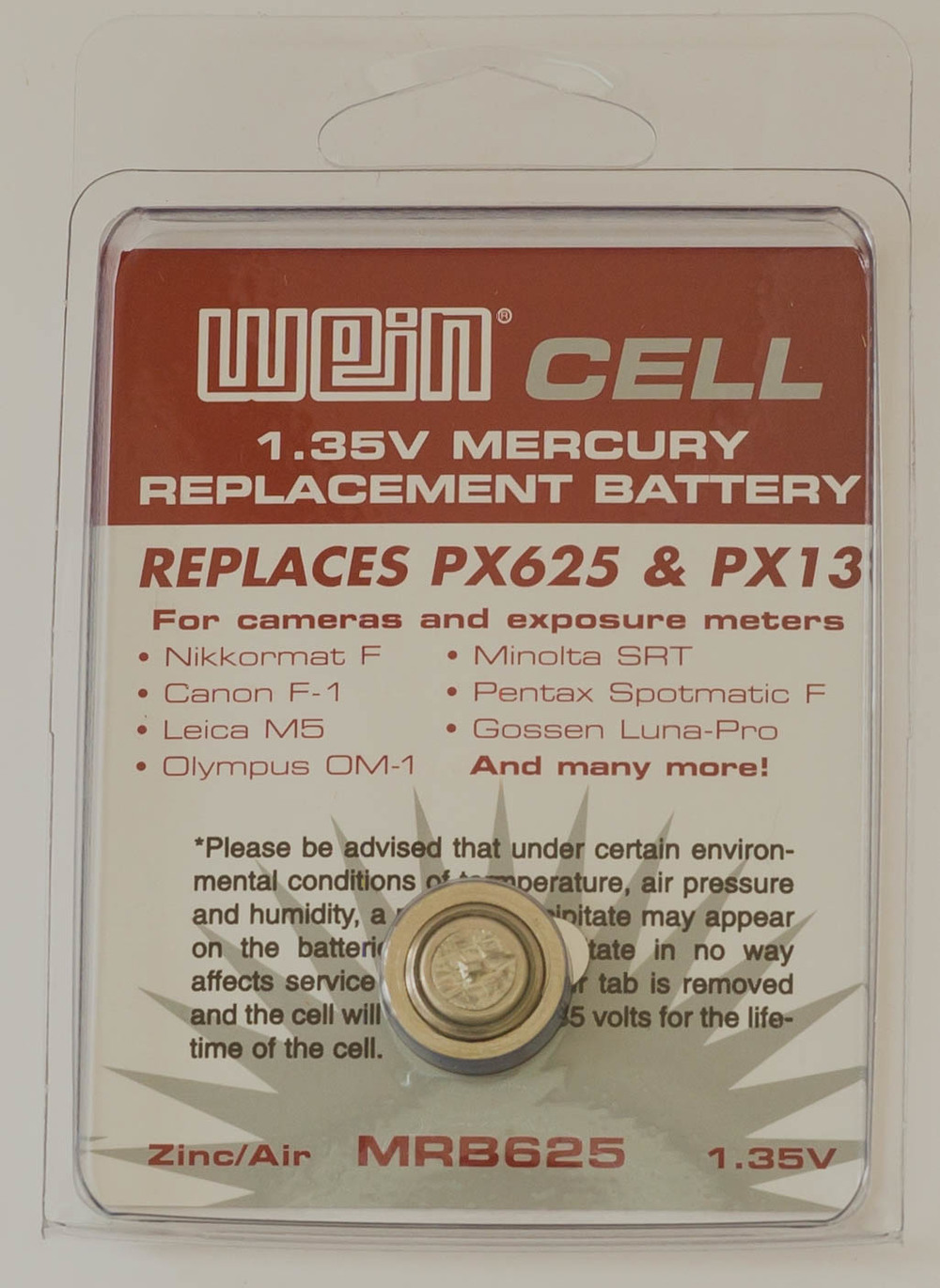
Disappearing act
Just like Lord Lucan, the original mercury oxide batteries for the M5 also disappeared following their banning in many countries because of concerns about their toxicity and disposal. Modern alkaline PX 625A batteries, which will fit in the M5 (mine came with one), are 1.5 volts. This raised voltage will give a false meter reading since the the M5 was designed for a 1.35 volt battery. You can, I believe, have the M5 adapted to use 1.5 volt batteries and you can also cheat the meter by setting the wrong ISO. I have a Leica CL that seems to have been adapted for the modern 1.5 volt batteries.
However, when Mike Evans mentioned the Small Battery Company on in a comment to an article on Macfilos a few weeks ago, I thought that I would check their website to see if they had a solution for the M5 issue. Sure enough, I saw that they had the 1.35 volt Zinc/Air Wein Cell batteries and placed an order straight away. The battery arrived here in Dublin in double-quick time (thanks Jim) and I discovered I had to remove a tab at the back for about 30 minutes before use. Presumably, this is to get the mix right for the charge. Here is the packet in which the battery comes. You will see clearly that it is indicated as suitable for the Leica M5.
Cross checking
I checked my M5 meter with the Wein Cell fitted and I found that it more or less matched my other meters , both hand-held and in-camera. With the M5 the meter sensor swings up on a lollipop-type arm. The sensor is about visible here. To take this photo, I had to ‘fool’ the M5 into thinking that a lens was fitted by putting on an adaptor. It will not appear unless it the camera ‘believes’ that a lens is fitted as here.
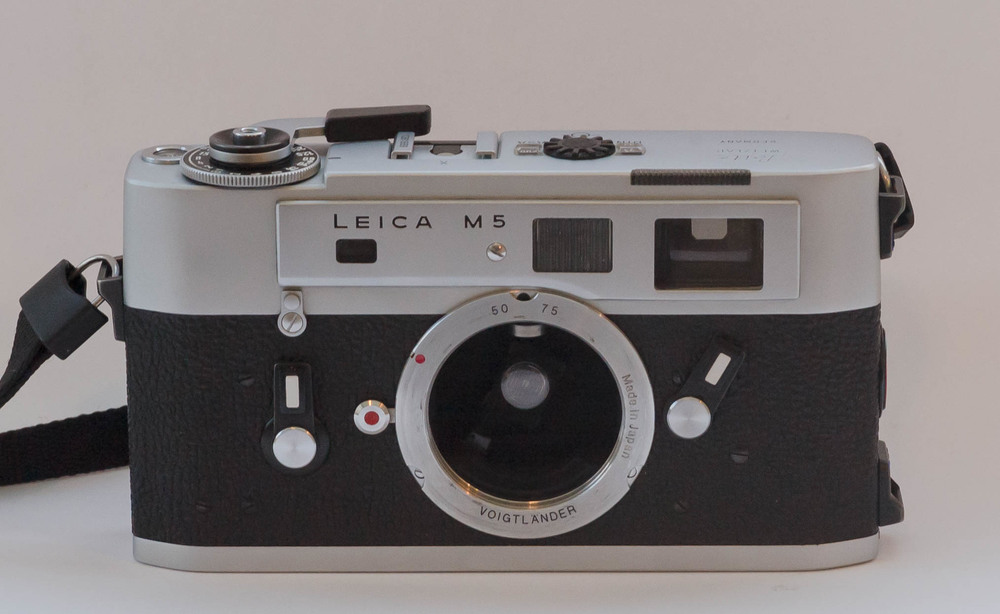
When taking a meter reading you must make sure that, unlike with modern digital cameras, your finger is not on the shutter button. If you depress the shutter button you will get a false reading. The next thing was to test the camera and its new battery cell in the field. My first choice was to fit a 1950s Summarit 50mm f/1.5 with its XOONS hood as shown below. This is a really excellent lens, which, while it pre-dates the M5, has image quality that is outstanding.
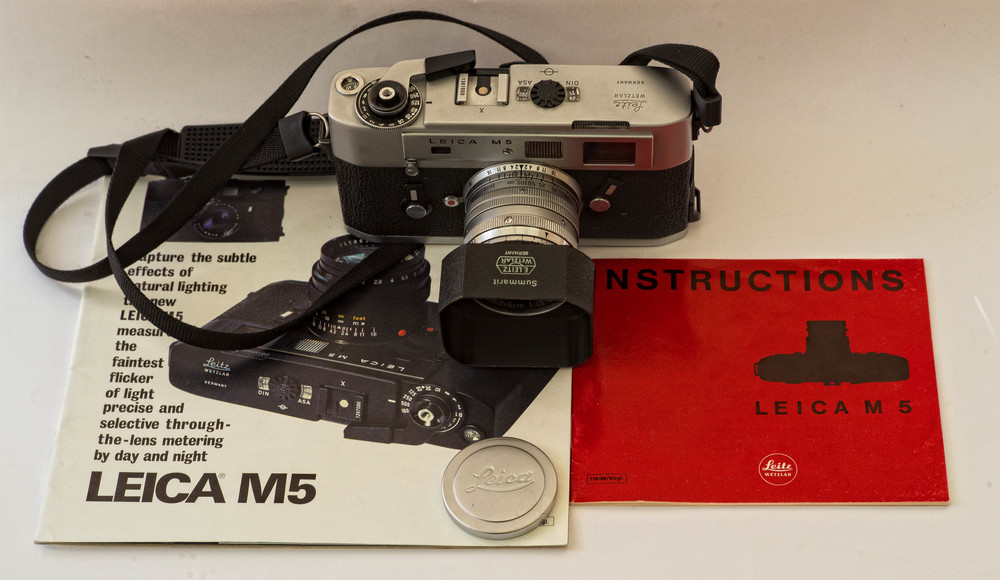

One of the features of the M5 is that it has different metering areas depending on the focal length of the lens used. Here is the description of this feature in a number of photos in the camera manual (I acquired a collection of the manuals for all film Leicas some years ago).
The first one shows how the metering area changes with different focal lengths.

The second one shows how the match-needle metering works. Note that the set shutter speed is visible; something you will not get with an M240 today unless you use Live View or an EVF. On the other page you can see what is visible in the viewfinder as regards frame-lines and metering areas.
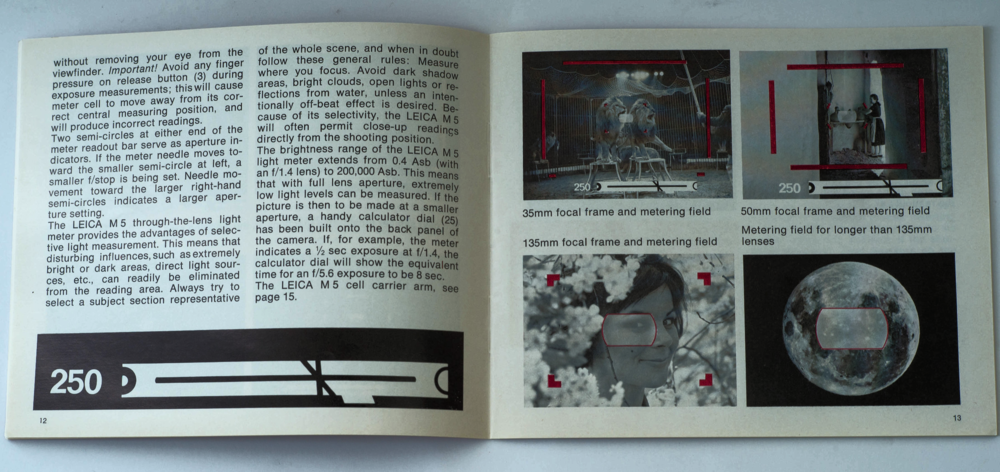
The change in the metering area feature is perhaps more important for transparency film than it is for negative film, where there is a wider exposure latitude.
I also decided to test the M5 with a longer focal length; in this case the 90mm Summicron.
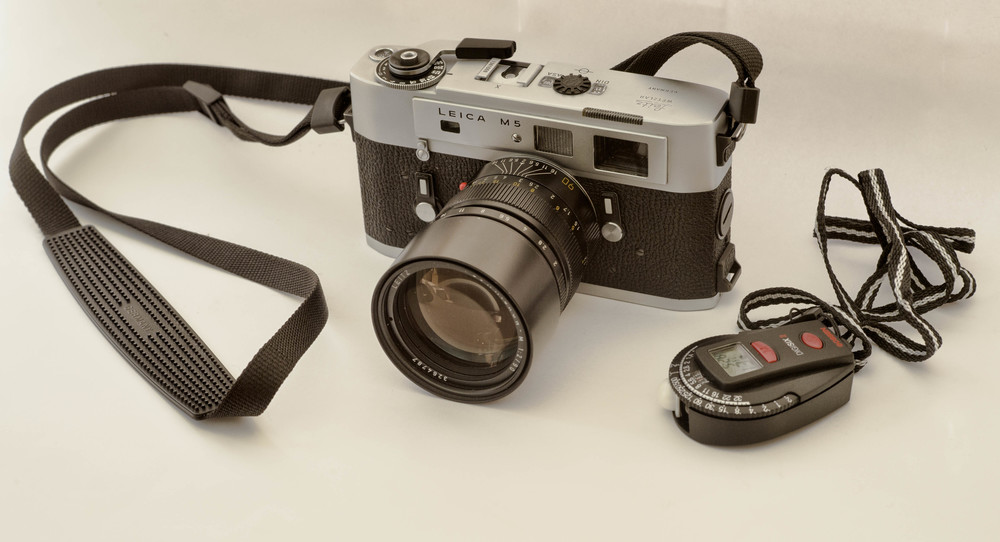
The lens and camera are shown with the Gossen Digi-Six 2 which I used to check the Leica M5 meter. This has a lovely feature of having a digital read–out which, when the reading is converted to the outer wheel, shows the correct aperture for all relevant shutter speeds at a glance. I find it very quick to use.

Heavy
With the 90mm fitted, the combination is one heavy lump. I might as well add my comments here on what the camera is like to use. I am six-feet tall but I have smallish hands and, to be frank, I find this an uncomfortable camera to use. I find it very difficult to grip it on the right hand side and to depress the shutter at the same time; it needs to go down a long way in order to fire. In addition there is a small but very sharp-edged knob on the top of the rewind lever which shreds my fingers as I hold the camera. I also don’t like the self-timer lever but that is not as much of a problem as the rewind lever. Looking at the photo in the manual , the guy holding the camera has huge hands. I simply cannot hold the camera like this.
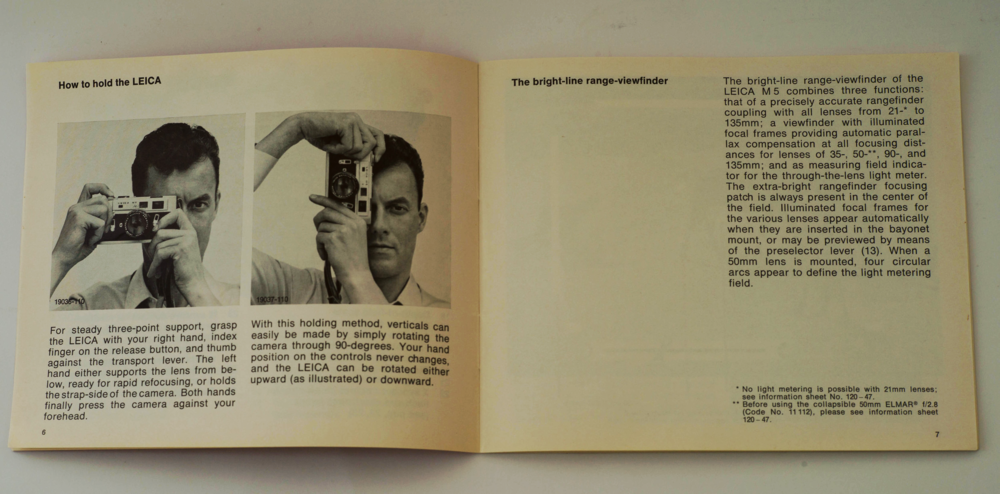
I do know how to hold a Leica M camera as I have all of the other models from the M3 up to the M7. I tried an M3 afterwards and my fingers fell into place as usual with no discomfort whatsoever. The solution to the M5 may be to wear gloves or to use an ever ready case—but who wants to have to do that? I wonder who Leica used to test the handling of this camera before it was launched. Perhaps the guy with the big hands in the manual?
The M5 was an advanced camera for its day but it was not a success. It did not look as well as its predecessors and, in my experience, it does not handle as well. Customers were being asked to make a lot of handling sacrifices in return for a built in meter. I am sure that a few people will say that the camera suits them handling-wise but I can only report on how it is for me.
One thing is beyond argument, the camera can take excellent photos.
Here are other photographs taken with the M5 and the two lenses. Click to enlarge.
.jpg)
.jpg)
.jpg)
.jpg)
.jpg)
.jpg)
.jpg)
.jpg)
In summary, therefore, the camera is a bit of a ‘curate’s egg’ for me. Other views would be most welcome.
- Subscribe to Macfilos for free updates on articles as they are published. Read more here
- Want to make a comment on this article but having problems? Please read this
- If you have any battery requirements check out the Small Battery Company.






I’m only 5’9” and have slightly larger than average hands. The M5 is my favorite 35mm film camera, by far. It is comfortable in the hand, has the wonderful build quality of all pre-M4-2 Leicas and the meter is to die for.
I had Sherry Krauter convert mine to 1.5 volt and just modern Alkalines. I put a new one in every half year and have no issues of them wearing out unevenly as they last longer than I keep them.
My M5 has the most accurate built-in meter of any camera I own, including the Leica M10 and Canon 5D3.
Andrew, one of these days I must try an M5. It is one series I don’t own — from 1930 through to the current M7 — and it is clearly an omission!
Hi William,
It was excellent to meet you this weekend, and thank you for letting me know about this piece, which I enjoyed reading. My experience with WEIN cells is mixed, to say the least. I used them on a couple of Leicameters, but found that on average they would not last longer than a couple of months, despite being rather expensive. The far better solution was to use an MR-9 adapter (see criscam.com, or the small battery company in the UK), which lets you use the ubiquitous and cheap silver oxide 386. You sum up the M5 very well – handling sacrifices in return for a built in meter. Even so, that built in meter is so awesome – a true spot meter, with all exposure date clearly but unobtrusively displayed in the viewfinder, unlike every other Leica rangefinder – that it is difficult not to love the M5, at least for certain tasks. Hope you had a good flight back! Alfonso
In Bristol Airport on my way back from the Leica Society AGM. At the meeting, a fellow member told me that I should have said that one should not collapse a collapsible lens on an M5 for fear of breaking the ‘lollipop’ device which carries the meter sensor. As I recall, there is some advice on this in the M5 manual. I had meant to include this in the article when doing the final draft but it slipped my mind.
William
This is such a wonderful article, William. I have always been very curious about the M5, and have never seen or handled one in real life. I’ve seen and heard opinions that have raved about it, and many that have cursed it. It just seems like a bit of an outlier. Ironic given how brilliant the simplicity of the metering system is – it seems like it gives you all the information you need.
There’s something nice about a linear needle-type meter in a camera. One of my very favourite cameras was a Konica Auto S2, which seems to have a very similar design. I found it extremely useful! Like you, I’m 6′ with tiny hands, so I suspect I’d also gravitate back to the M3.
Some truly beautiful images, here – in spite of your experiences with the camera. For ages I’ve thought the Summarit would be a fantastic lens, and I’m half tempted to invest in one, now. I’ve always loved its swirly bokeh, and I’m convinced it would be tack sharp for most purposes.
Adam
Thanks Stephen and Claus. You can get used to the position of the needle with practice; I had some issues at first. You can also deal with some of the sharp edge issues using the solutions I suggested. You cannot, however, make the camera any smaller. I would suggest that anyone, who has concerns on that score, should handle one before purchase. I bought mine at auction.
William
Nice pictures William… I handled one of these at RedDot cameras recently, I didn’t notice the handling difficulties, but I really didn’t get to use it in anger… indeed, I sort of liked its oddball appearance.
What I did have a problem with though, was I found that I had to look right into the viewfinder and sort of move my eye around, to see all all of the light meter scale and needle, as soon as I reverted to my normal eye position the scale disappeared.
Never mind, all a bit academic anyway as I did not buy it.
Good to hear that the Wein cell worked for you, as with Claus, I have one for my MR lightmeter, and apart from the fact that I can’t focus on the message, the readings are accurate, if I put some specs on!
Dear William,
congratulations on breathing live again into the – let’s say ‘misunderstood’ – M5. I never handled one personally and happen to have small hands either, so it’s interesting to hear about your qualms in handling the camera.
btw, I happen to have the exact WeinCell in my drawer, as replacement for the one in my Leicameter MR. But miraculously, the power in the old cell never drains (being about 50 years old).
Best Regards,
Claus